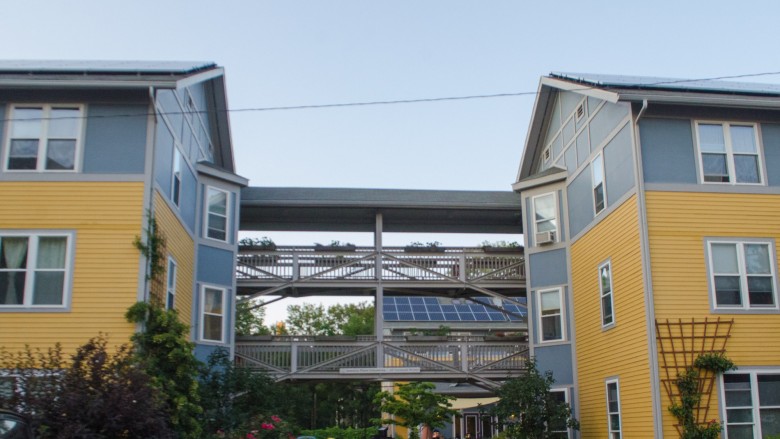Creating community: Boston cohousing
By Beth Treffeisen | August 31, 2015, 5:00 EDT

Lifestyles and living habits are changing in many Boston-area neighborhoods. Many younger people are opting for multiple housemates to off-set the cost of higher rents, while others are moving home to live with their families. Some seniors who do not want to move to pricey assisted living facilities are deliberately moving close to each other within their own communities. And some working families living in single-family homes are devising creative solutions to the problem of urban and suburban isolation.
“I don’t know my own neighbors, and I am very community focused person,” said Peter Goldstein, one of the co-founders of the “cohousing” group Bay State Commons. “And they are my age. It’s very awkward.”
Cohousing, an effort to bridge the gap between older residents looking for community and younger families trying to create an intentional community across generations, is catching on in Boston.
“Really cohousing is an old-fashioned neighborhood idea,” said Pattie Lautner co-founder of the Jamaica Plain Cohousing Community. “In the 50’s, my mother’s generation, the people were already friendly with their neighbors because we didn’t have the two-income households going to work.”
Since mothers were usually at home with their children in previous generations, neighborhood collaborations were established to provide shared childcare, chores, and mutual support for common problems.
“People have identified raising children when both parents work as very challenging and [say that it] can be socially isolating in and of itself,” said Goldstein. “They hear that this is an option and they think ‘Oh my goodness how long have we been using this phrase: it takes a village to raise a child?’ It turns out there is a way you can do that.”
According to Raines Cohen, a spokesperson for the Cohousing Association of the United States, the system provides a community that residents design and run together. It is an intentional home in which residents share a common dwelling site, but have their own living apartments or houses. Residents routinely help each other with chores and share meals together several times a week.
Alice Alexander, President of the Cohousing Association of the United States, says that “a big feature of cohousing is sharing meals together, which may happen once, twice or a more a week.”
By sharing cooking tasks and meals together, members are able to have frequent contact and also get to know each other.
In the U.S. there are currently 153 established cohousing communities. Massachusetts alone has 17 groups, including those that are already established along with newly-developing sites. Jamaica Plain has one community, and Cambridge has two. According to the National Cohousing website, the “living community” idea originated in Denmark and was brought to the U.S. by Kathryn McCamant and Charles Durrett in the early 1980’s. Since then, the Danish concept has become increasingly popular.
Cohousing aims to find a suitable balance between privacy and community while maintaining the flexibility to create different housing choices. Members own their condos and houses and do not share personal money or common businesses, as in Israel’s Kibbutz system. Instead, the groups are specifically designed to promote social interaction among the various members.
“We like to refer to ourselves in our community as cousins,” said Alexander. “They’re not always necessarily my best friend but they are people that I can count on who will help me, who are there, who care about me and I care about them.”
One of the unique features of cohousing is the special design of the living spaces. Instead of having garages and driveways that separate houses and condos, the cars are parked around the periphery with open outdoor spaces in between.
For example, the Cambridge co-housing design includes a communal garden that connects townhouses together, and a playground located on top of a parking garage. In this way, members have access to larger plots of land than they normally would find or be able to afford in a city.
“My vision that I have is arriving home at the end of the day and you’re in your usual burnt out state,” said Goldstein, who is planning the future Bay State Commons shared dining room. “You’ve done your work, you’ve done your commute and [have] all these little things that are bugging you – and [then] sort of opening the door into the common room and just sort of having that Cheers Bar moment.”
The new designs for common spaces allow people to learn each other’s names and foster spontaneous interactions between neighbors. It also promotes a lifestyle that is more environmentally friendly. For example, instead of everyone having his or her own car, many members opt to share a single vehicle using a sign-out system. Both the Jamaica Plain and the Cambridge Cohousing developments have dedicated bike rooms, along with gardens that provide produce for group meals.
Creating this unique structure involves some difficulty with construction, especially in urban areas. For instance, Goldstein is working with Bay State Commons to find a new cohousing site in the Boston outskirts. He has found the process challenging, since he needs to find a suitable place that caters to everyone’s needs, such as good school systems and close proximity to public transportation.
“I would never have learned so much about the real-estate market, architecture and all this stuff had it not been for this project,” said Goldstein. “And everyone who is involved now is the kind of person who is just really eager to learn.”
Goldstein helped start Bay State Commons to specifically address the large demand for cohousing in Boston and Cambridge. While there are plenty of potential sites in rural areas, the cities and their suburbs pose a greater problem due to lack of space.
“I know that this is true because whenever we have a unit for sale we sell in a day, even in the down [market] of 2008 and 2009,” said Lautner. Still, she believes that more effort is necessary to cultivate local markets since cohousing has not generated sufficient mainstream interest, despite being in the U.S. for over twenty years.
Alexander notes that, while cohousing has gained traction since the 1990’s, it has never enjoyed a widespread demand. She adds hopefully, “we are trying to create the demand.”
According to Cohen, the type of people interested in cohousing tend to be civically minded and well-educated, with a majority having advanced degrees. While senior cohousing numbers remain steady, the Boston area trend is higher among intergenerational groups that include families with small children and older adults.
Cambridge Cohousing Co-founder Norma Wassel believes that there are multiple reasons why people join the organization. She cites examples such as parents with special needs children who prefer supportive surroundings, and empty-nesters who wish to downsize their belongings without downsizing their lives.
“Some people as they age want to have more intergenerational contact, instead of going to a retirement home,” said Wassel. “Some people want to downsize but were [also] leaving their family and community and wanted a more involved support system.”
At the same time, cohousing is not for everyone since there is an implied expectation of sharing. Furthermore, decisions often require a consensus, or general agreement among all the residents. This exigency is a rather demanding prospect for some, since it requires frequent discussions and the willingness to abide by group decisions rather than personal preferences.
But the demands are not overwhelming. “We’re not just going to vote you off the island. We’re going to try and find that common ground,” said Cohen, who also believes that cohousing living is desirable because you get to know your neighbors, even if it requires some effort: “It’s been called the most expensive personal development course that you will ever take.”
Contact Beth Treffeisen at [email protected]











